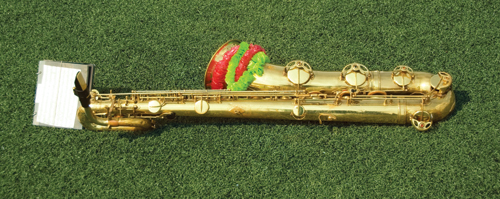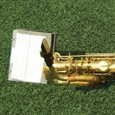
Each year, it seems like we begin preparing for marching band earlier and earlier. A director has many tasks as the season approaches – preparing every measure of music and each set of drill, ordering colorguard flags, and establishing front ensemble instrumentation – and it is vitally important that we also focus on the individual preparation process for each of our students. We try to focus on three main areas in which we can help our students as they ready themselves for the coming marching season: musical preparation, physical fitness, and program connections/retention.
Musical Preparation
Before we begin to prepare the music in our marching show, we must first prepare our students to sound their very best on the first day back from the summer. The first key is to establish a good personal warm-up routine. We try to tailor the warm-up process to suit each student based on individual ability levels after auditions are held in May. The warm-up process should begin with several exercises that focus on the initiation of sound. For this, we use the Low Bb Remington exercise (discussed in the January 2014 article), played at varied dynamics. From this, we transition into F Descending Exercises. This portion of the personal practice time is not too long; it may take up 10 minutes of a 60-minute practice session.
Following the initial warm-up, we ask students to work on scales in the key centers that will be used in the coming production. In addition, we sometimes compose several daily drill exercises that will help sections prepare for their featured moments in the show. For example, we might write a double-tonguing exercise for the high brass, or we might design a scalar passage that modulates up or down in order to prepare for an upcoming woodwind feature.
The next portion of personal practice time should be spent working on show excerpts. The first thing to emphasize in working on the excerpts is a set of expectations with regard to tempo. If a production will ultimately be performed at mm=160, we may ask that it be performed from memory at mm=120 by July 1, and at mm=144 by August 1. In addition, at an early stage, we begin to have the students mark drill sets into the music, so that, while practicing, they can learn the count structure of the show with step-offs and halts. We advocate a short, five-minute warm-down at the conclusion of the practice session, and for this, descending scales, Remington exercises, and long tones (low, descending chromatically) are very effective.
Designing an effective musical work-out plan for our students to use in their individual practice sessions is a first step toward beginning the season with ease in July and August. It is vitally important to share this plan with each student, as well as with each student’s parents. We do not want to hear the parents saying, “He doesn’t know what to practice” or “She has nothing to work on.” The partnership between the band staff and the parents is critical during the summer months. Although we may not see one another regularly during this time, the band parents know that the best way they can help the marching show in October and November is to ensure that their child practices diligently in June, July, and August.
Physical Fitness
To handle the increasing demands placed on our performers in both the marching drill and standstill body work, we have developed an exercise regimen tailored to students and the types of shows we program. Our goal with the exercise regimen is to help students be able to perform high-level drill and play their instruments well, without any risk of breaking down physically or mentally.
We first introduce the physical fitness program at our marching band preview day in mid-May. On that day, every student who plans to audition for the ensemble next year takes part in a mini-camp in preparation for marching band. During the first hour, we present our system, which involves an extensive amount of both stretching and running, as well as some core strengthening exercises and yoga poses. Ultimately, it is important to introduce exercises that will prove useful when working through the drill and dance movements required in the show.
The exercise system begins with a set of stretches. Many programs use a stretch-to-counts routine that cycles each student through a total relaxation and breakdown of the posture. After the posture breakdown, students are slumped over, and then they rebuild a lifted marching band posture that ends in a perfect horns-up pose without the instrument in hand. To see an example of what works for us, check out the video on our website (www.wakelandband.com/instrument alist).
Following the silent stretch-to-counts exercises, we transition into some basic stretching exercises aimed at preparing the upper body. For this, we usually do 10 small forward arm circles; 10 small backwards arm circles; 10 large forward arm circles; 10 large backward arm circles; rolling the neck – forward, left, back, and right; and, at times, we add in some jumping jacks to begin to raise the heart rate.
From there, we work to stretch the lower body with a set of 10 relevés in each of a few dance positions (1st position, 2nd position, 3rd position on the left, 3rd position on the right, 5th position on the left, and 5th position on the right). On each relevé, we ask the students not to return the full weight of the body to the ground, but to keep it slightly elevated, aiding in the stretch process. We also use a series of on-the-ground stretches, including toe touches with both legs out, and with one leg tucked under. At times, we also add a similar set of exercises, but performed in the standing position (especially if we are rehearsing on hot concrete or wet grass). We execute toe touches with two feet together, then with the left foot crossed over the right foot, and then with the right foot crossed over the left foot.
Following the stretch process, we move into a light run. We begin the season fairly easy, often with running the quarter-mile. We have a timer going at all times so that students will compete against yesterday’s time rather than against each other. As we settle into summer band, we begin to add to the distance, eventually assigning a full mile. In our 300-member ensemble, 95% of the students are able to complete the mile in under 10 minutes with an average time of 8 minutes and 35 seconds. Before assigning the run, it is important to visit with parents and your school’s athletic training staff to make sure that the exercise program is safe for each student. In certain parts of the country (like here in Texas), limitations on exercise based on temperature and relative humidity may be in place. Please consult with your school administrators before implementing a stretch-and-run plan to ensure that it meets all guidelines for the campus and district.
The final portion of our stretch-and-run exercise focuses on core strengthening. After returning from our run, we take a short water break and then move into a series of core-strengthening exercises alternating with push-ups or sit-ups. For core-strengthening, we employ left leg lifts, fire hydrants (held for 30 seconds), and Supermans (lie face down, lift arms and legs). We often find that core strength is one of the areas that helps us most on the field in terms of visual presentation. Good core strength helps our students to be able to present the look we want on the field. Students who at first appear slumped over with their horns up can quickly rise to great posture in just a few weeks after they practice core strengthening exercises. Most students experience rapid growth as they move through their middle school years and into high school, and very few students work on their core strength on a regular basis. Teachers in athletics at our school have sometimes commented that we in the marching band work on this aspect of physical training more than any other athletic team.
Lastly, it is important to sell the physical fitness plan in order to get students committed to this work. One of the ways we are best able to institute our fitness plan is by having the entire staff (if they are physically able) perform the workout routine with the students each day. One staff member leads the workout, while the others position themselves around any students who might need help or who may need to be monitored during the process. When the students see their band directors, many of whom are twice their age, performing these exercises with ease, the initial complaints quickly give way to, “I can’t wait to beat Mr. Miller on the run today.” This approach of having teachers participate in exercises, while perhaps a bit non-traditional, helps tremendously in building a rapport with our performers as we embark on the long season ahead.
Program Connections/Retention
As mentioned earlier, we annually convene for a mini-camp in the spring, a day that is referred to in our program as “Hype Day.” On a Saturday in mid-May, we gather every performer who intends to audition for us in the coming weeks to spend a day as a member of our program. This includes all new students preparing for wind, battery percussion, front ensemble, and guard auditions, as well as every returning member of the band program. This is a day for the full ensemble to be put through the paces of an average marching band day. The day consists of a stretch-and-run, a short marching technique block, a meal served by our band parents (as well as campus principals and district administrators), a short music block, and a show-and-tell at the end of the day.
The agenda of the day provides a way to begin forging relationships and to help codify the members of the ensemble for the year to come. Each year, we see a number of fence-sitters – students who still aren’t sure about enrolling in high school band – come around as they decide that band really is a place for them to belong. Sections eat lunch together and get to know one another. Students moving into the attendance zone of our campus are also invited to this event, and they get a chance to be introduced to the ensemble. The day is about easing transitions, establishing a level of rigor, and building relatioships. Although our juniors may be only mildly anxious about becoming seniors, the 8th graders often approach the day with some nervousness and trepidation. After all, most of what they have seen from our ensemble takes place after months of preparation, and sometimes they cannot fathom how we could improve from where they are now to where the ensemble later will perform. Hype Day helps to ease those tensions. The new students gain a sense of how we teach, and they soon learn that our approach is methodical, patient, kind, encouraging, and enjoyable.
At the conclusion of the day, we invite every parent of a student in the program (both old and new), as well as our alumni from recent years (many of whom are already home from college), to hear the first strains of the new marching band show. We do not play very much of the show, but we do offer a great indoor experience for all involved (we prefer to hold this show-and-tell part indoors because it makes the ensemble seem both larger and louder, which will help the students and parents feel confident about what’s to come). The colorguard performs a short flag phrase to a popular tune, the drumline and front ensemble play a short piece that they learned that day, and the wind section plays some show excerpts. At the end, we bring every student out onto the floor of the gym for a pep rally-style concert with all the community’s marching band favorites, concluding with the fight song. In talking with parents over the years, many of them have said that this was one of the most emotional experiences of their child’s career in our school. For many, this was the first moment when they realized that their child was about to be in high school, and about to begin an incredible journey in one of the most fulfilling activities that any campus can offer.
For ongoing recruitment and retention, we use social media during the summer to generate some enthusiasm and energy. We post videos about the marching show, tweet pictures of guard uniforms and flags as they arrive, post videos of props being tested in the stadium, and albums of pictures from mini-camps, sectionals, and social gatherings. The more we can create a vibrant social activity that makes us seem always present, the more students will flock to our program. We refer to is as the “power of the re-tweet.” If the one 8th grader who chose not to play clarinet sees nearly every one of his or her friends posting and re-tweeting pictures of pool parties with band members, images of show artwork, or other updates, he or she may begin to re-think the decision not to join marching band, and we often see some of these students come back into the fold by the time summer band begins.
Conclusion
Through diligent preparations in the spring and summer, students can begin the marching band experience with a well-prepared mind and a body that isn’t quite as sore as it might be. The right preparations will instill in students a great sense of commitment and a sharp focus on their work as they embark on a wonderful journey that will fill their high school years with memories to last a lifetime.






